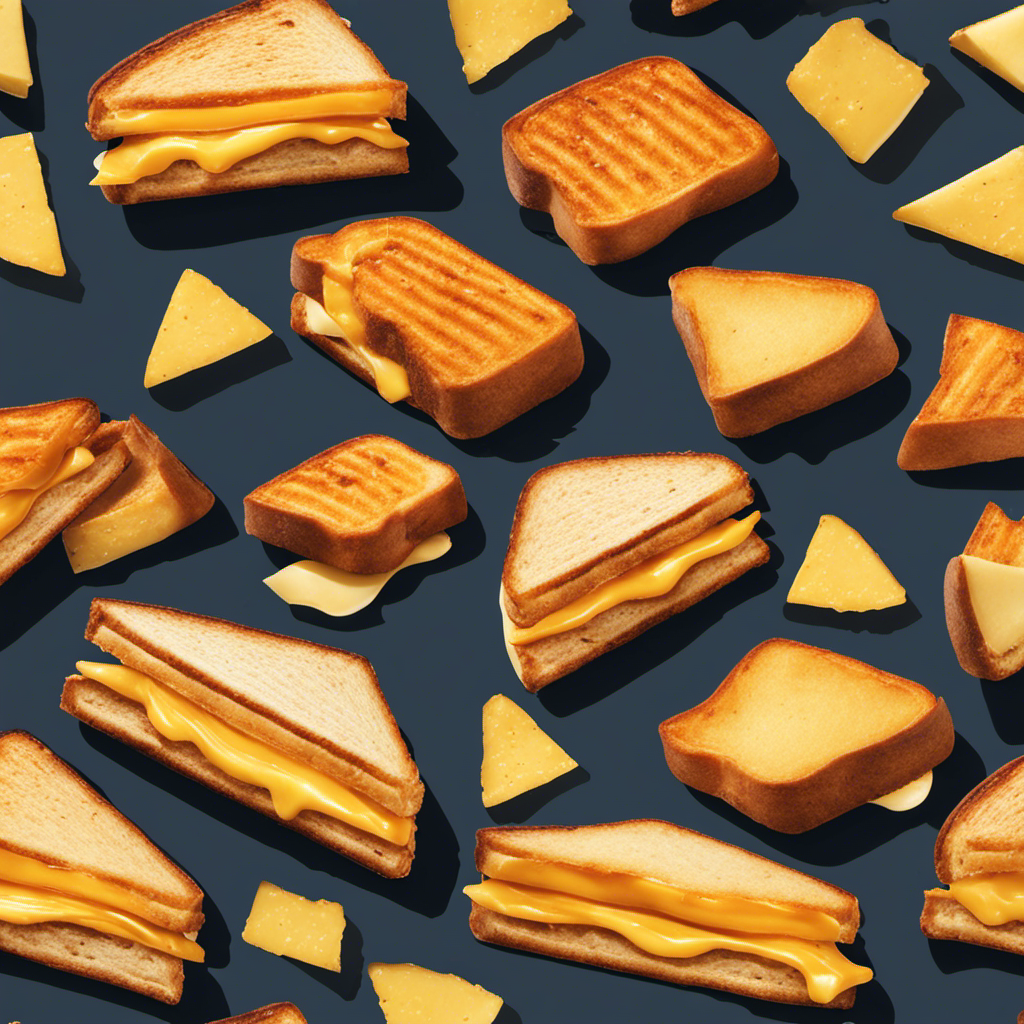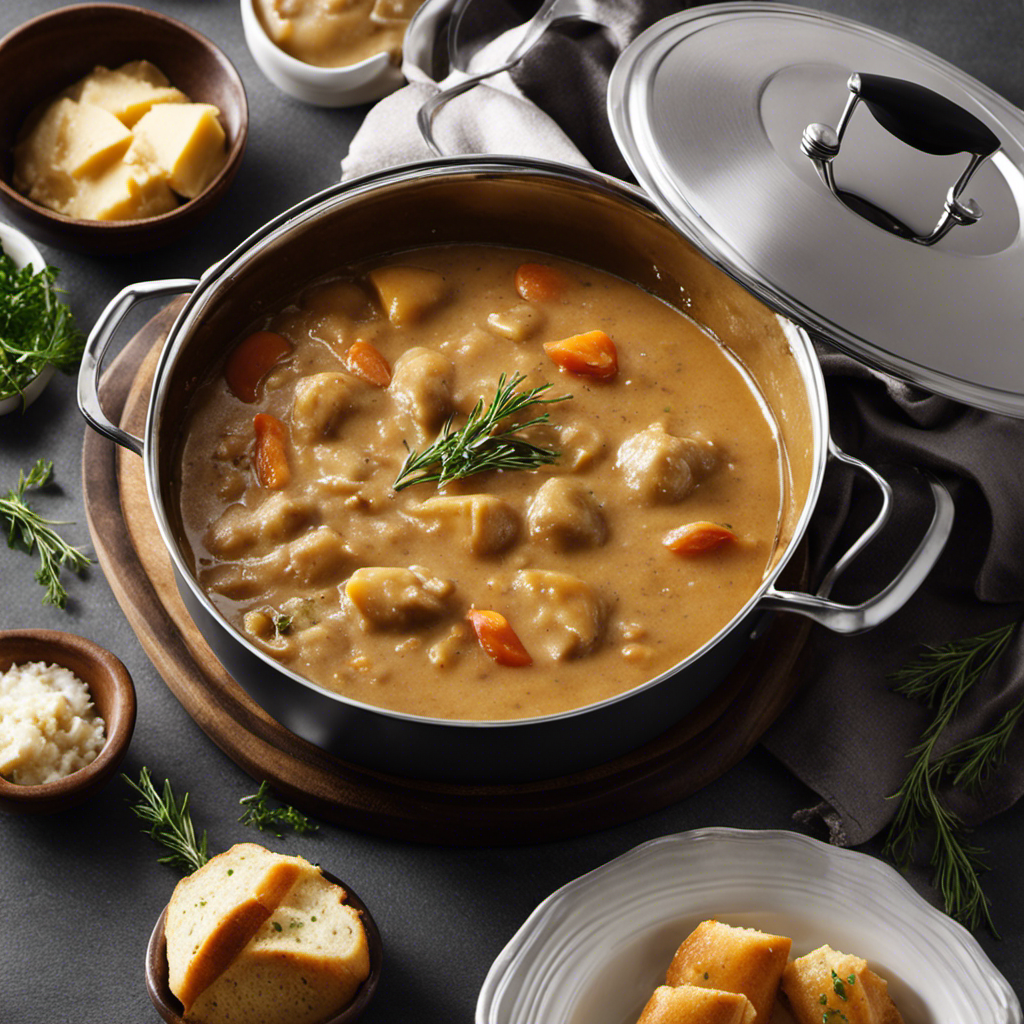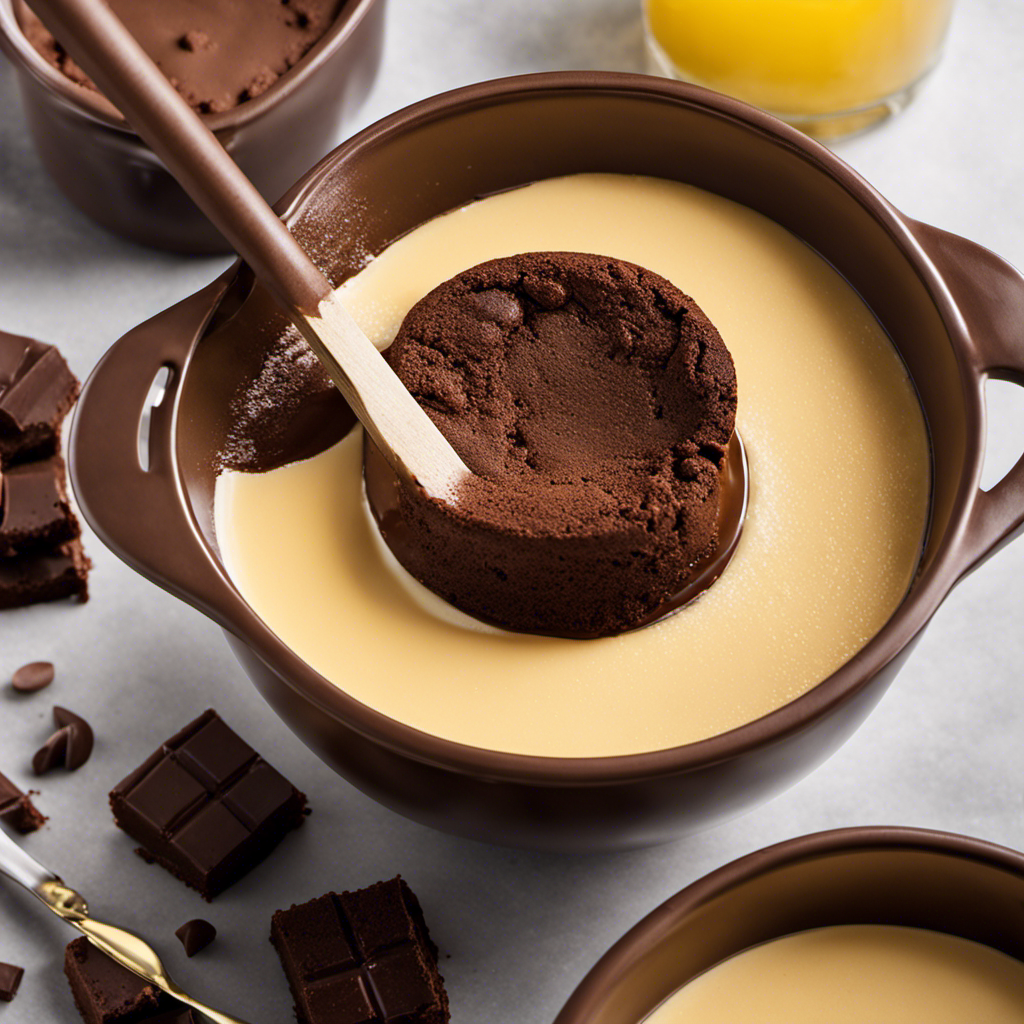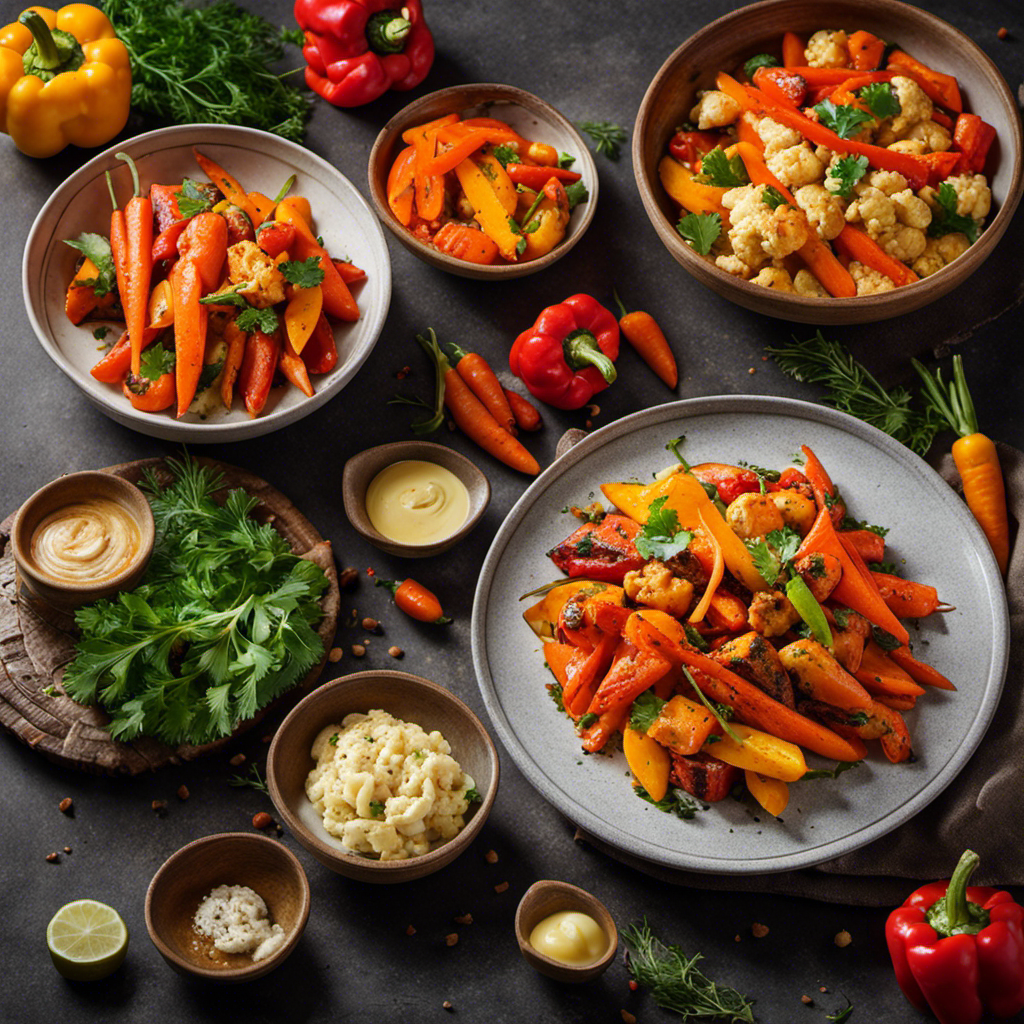I have always enjoyed the soothing smell and gooey goodness of a grilled cheese sandwich, but what do you do when you run out of butter? Do not worry, cheese enthusiasts!
In this article, I will guide you through the art of making a mouthwatering grilled cheese without butter. From choosing the perfect bread to selecting the right cheese, I’ll provide you with all the tips and tricks you need to create a delectable sandwich that will leave you wanting more.
Get ready to tantalize your taste buds and dive into a butter-less grilled cheese adventure!
Key Takeaways
- Use alternative spreads like avocado or olive oil for a healthier option and different flavors.
- Experiment with different bread types and cheese varieties to elevate the sandwich.
- Consider toppings like caramelized onions, crispy bacon, or apple slices to enhance the flavors.
- Use non-stick pans and control the temperature for a golden, crispy exterior without burning the bread.
Choosing the Right Bread
You’ll want to choose a bread that is sturdy enough to hold your grilled cheese sandwich together without butter. One option is toasting the bread before assembling the sandwich. This not only adds a nice crunch, but also helps to prevent the bread from becoming soggy.
You can experiment with different bread types to find your favorite. For a classic grilled cheese, try using a thick-cut white bread. Its soft texture and mild flavor pair perfectly with gooey cheese. If you prefer a heartier option, opt for a whole grain bread. Its nutty taste and dense structure add a delicious twist to the traditional grilled cheese.
Don’t be afraid to get creative and try out different breads like sourdough, rye, or even gluten-free options. The possibilities are endless!
Selecting the Perfect Cheese
Choosing the right cheese is essential when creating a delicious grilled cheese sandwich without butter. Not only does the cheese provide the main flavor of the sandwich, but it also contributes to its overall texture.
When selecting cheese for your grilled cheese, it’s important to think outside the box and try unique flavors that will elevate your sandwich to new heights. From sharp cheddar to creamy brie, the possibilities are endless.
Additionally, experimenting with different cheese textures can add a delightful twist to your sandwich. Whether you prefer a gooey and melty cheese or a firm and crumbly one, there is a cheese out there that will suit your taste.
Preparing the Cheese Slices
When it comes to grilling, finding the perfect butter alternative is key. Whether you’re looking for a healthier option or simply want to experiment with different flavors, there are plenty of alternatives to choose from.
In addition, melting cheese without butter is a great option for those who are lactose intolerant or simply want to avoid using butter altogether.
Butter Alternatives for Grilling
Using a butter alternative, spread it on the outside of the bread slices for grilling the perfect cheese sandwich. When it comes to choosing healthy options for your grilled cheese, there are plenty of alternatives to traditional butter. Experimenting with different spreads can add a new twist to your sandwich while still keeping it delicious and satisfying.
Here are two options to consider:
-
Avocado: Mash up a ripe avocado and spread it on the outside of the bread slices. Not only does it provide a creamy texture, but it also adds a boost of healthy fats and nutrients.
-
Olive oil: Drizzle a small amount of olive oil on the outside of the bread slices. This adds a light, Mediterranean flavor and helps achieve a crispy, golden crust.
By trying out these butter alternatives, you can explore new flavors and make healthier choices without sacrificing taste.
Now, let’s move on to the next section where we’ll discuss how to melt cheese without butter.
Melting Cheese Without Butter
To melt cheese without butter, you can try using a non-stick pan or a microwave-safe dish. These alternatives are great for those who are looking for vegan grilled cheese options or simply want to avoid using butter. In a non-stick pan, heat it over medium-low heat and place your cheese on top. Let it melt slowly, flipping it once to ensure even melting. Alternatively, you can use a microwave-safe dish and microwave the cheese in short intervals, stirring in between until it’s melted to your liking. Here is a helpful table to compare these methods:
| Method | Pros | Cons |
|---|---|---|
| Non-stick pan | Even melting, no need to flip constantly | Requires stovetop |
| Microwave | Quick and easy | May not melt as evenly |
Both methods work well, so choose the one that suits your preference and enjoy your melted cheese without butter!
Enhancing Grilled Cheese Flavors
If you want to enhance the flavors of your grilled cheese, try adding different types of cheese or toppings like caramelized onions or bacon. Experimenting with different combinations can take your grilled cheese from ordinary to extraordinary.
Here are some creative toppings and cheese pairings that will surely tantalize your taste buds:
-
Toppings:
-
Caramelized onions: The sweet and savory flavors of caramelized onions add a delicious depth to your grilled cheese.
-
Bacon: Crispy bacon not only adds a smoky and salty flavor but also provides a delightful crunch.
-
Cheese Pairings:
-
Gouda and apple slices: The creamy Gouda cheese pairs perfectly with the crisp and slightly sweet apple slices, creating a harmonious combination of textures and flavors.
-
Brie and fig jam: The creamy and buttery Brie cheese complements the sweet and slightly tangy flavor of fig jam, resulting in a rich and indulgent grilled cheese experience.
Assembling the Sandwich
When making a grilled cheese without butter, you can spread mayonnaise on the outside of the bread slices for a crispy and flavorful result. But what about the inside of the sandwich?
Assembling the perfect grilled cheese is an art form, and it starts with choosing the right ingredients. For those looking for alternative grilling methods, consider using a panini press or a grill pan instead of a traditional skillet. These tools can give your sandwich those coveted grill marks and extra crunch.
And for those following a vegan diet, there are plenty of vegan cheese options available. From plant-based cheddar to dairy-free mozzarella, you can find a variety of vegan cheeses that melt beautifully and add that creamy texture to your grilled cheese.
Heating the Pan
When it comes to heating the pan for grilled cheese, there are a few key points to consider.
First, using oil as an alternative to butter can be a game-changer. Not only does it provide a deliciously crispy exterior, but it also allows for a healthier cooking option.
Second, non-stick pans work wonders for ensuring that your grilled cheese doesn’t stick and easily flips over.
Finally, temperature control tips are crucial in achieving the perfect golden brown crust without burning the bread.
Oil as Alternative
Using oil instead of butter is a great alternative for making a delicious grilled cheese sandwich. Not only does it provide a healthier option, but it also adds a unique flavor to the sandwich.
Here are a couple of reasons why using oil substitutes can be beneficial:
- Health Benefits:
- Olive oil: Rich in monounsaturated fats, which can help lower cholesterol levels and reduce the risk of heart disease.
- Avocado oil: Packed with vitamins and minerals, it promotes healthy skin and boosts the immune system.
By using these oil substitutes, you can enjoy the same mouthwatering grilled cheese sandwich while reaping the health benefits.
Now, let’s move on to the next step: how non-stick pans work.
Non-Stick Pans Work
To achieve a perfectly cooked grilled cheese sandwich, you’ll want to use a non-stick pan. Grilling techniques can vary, but using a non-stick pan ensures that your sandwich doesn’t stick to the surface, resulting in a golden, crispy exterior. This type of pan also allows for even heat distribution, preventing any hot spots that could burn your sandwich.
When it comes to non butter spreads, there are plenty of options available. One popular choice is mayonnaise, which adds a tangy flavor and helps create a deliciously crispy crust. Another alternative is using olive oil, which adds a subtle richness to the bread. You can also try using non-stick cooking spray, which provides a light coating to prevent sticking without adding any extra flavor. Whichever spread you choose, make sure to apply it evenly to both sides of the bread before grilling.
Temperature Control Tips?
Now that we know non-stick pans are a great option for making grilled cheese without butter, let’s talk about temperature control techniques to prevent the cheese from burning. This is crucial for achieving that perfectly golden crust and gooey melted cheese.
Here are some tips to help you control the temperature effectively:
-
Adjust the heat: Start with medium-low heat and adjust as needed. Too high of a temperature can lead to burnt cheese, while too low may result in a soggy sandwich.
-
Preheat the pan: Make sure to preheat the pan before adding the sandwich. This helps to evenly distribute the heat and prevent any hot spots.
Preventing cheese from burning is essential for a delicious grilled cheese. By mastering temperature control techniques, you’ll be able to achieve that ideal combination of crispy bread and melted cheese.
Preparing the Pan for Grilling
Make sure the pan is heated before placing the sandwich on it. This is essential for achieving a crispy and golden brown grilled cheese without using butter.
There are a few heating methods you can try. One option is to heat the pan over medium heat on the stovetop. Another option is to use a griddle or a panini press. Both methods will give you that delicious grilled effect.
As for seasoning options, you can get creative with your grilled cheese. Add a sprinkle of garlic powder or a pinch of Italian seasoning to enhance the flavor. You can even experiment with different types of cheese or add some sliced tomatoes or bacon for extra deliciousness. The possibilities are endless!
Grilling the Sandwich on Medium Heat
When it comes to grilling sandwiches without butter, there are a few techniques that I’ve found to be incredibly helpful.
From using alternative spreads to achieving the perfect crispness, there are plenty of options to explore.
In this discussion, I’ll delve into the world of butterless grilling techniques, introduce some delicious alternative spreads for grilling, and share tips on how to achieve that sought-after crispy texture.
Butterless Grilling Techniques
First, you’ll want to explore alternative options for grilling your cheese sandwich without using any butter. Don’t worry, there are plenty of delicious alternatives that will still give you that crispy, melty goodness. Here are some ideas to get you started:
-
Choosing Bread Alternatives:
-
Whole wheat bread: For a healthier twist, opt for whole wheat bread which adds a nutty flavor to your sandwich.
-
Sourdough bread: The tangy taste of sourdough adds a unique element to your grilled cheese.
-
Experimenting with Different Cheeses:
-
Cheddar: The classic choice, cheddar melts beautifully and has a sharp, rich flavor.
-
Gouda: This cheese has a creamy texture and a milder taste, perfect for a more subtle grilled cheese.
Alternative Spreads for Grilling
Don’t forget to explore alternative spreads that can be used for grilling instead of butter. When it comes to making grilled sandwiches, there are plenty of options beyond butter. These alternative spreads not only add flavor but also provide a healthier twist to your grilled cheese. Here are some ideas to consider:
| Spread | Description | Benefits |
|---|---|---|
| Olive oil | Brushing olive oil on the bread adds a subtle, fruity taste and helps achieve a crispy exterior. | Rich in heart-healthy monounsaturated fats. |
| Mayonnaise | Mayonnaise creates a golden and crispy crust while adding a tangy flavor to your sandwich. | Contains eggs and oil, providing a creamy texture. |
| Avocado | Mashed avocado can be spread on the bread, giving a creamy and nutritious element to your grilled cheese. | Packed with vitamins, minerals, and healthy fats. |
| Coconut oil | Coconut oil imparts a slightly sweet and nutty flavor to your sandwich and aids in browning the bread. | Known for its potential health benefits and medium-chain fatty acids. |
These spreads provide a delicious alternative to butter and open up a world of possibilities for your grilled sandwiches. Experiment with different combinations to find your favorite. Happy grilling!
Achieving the Perfect Crispness
To achieve the perfect crispness, try experimenting with alternative spreads for your grilled sandwiches. While butter is the traditional choice, there are other options that can elevate your sandwich to a new level of deliciousness.
Here are some crisping techniques and spreads that will help you achieve the perfect crunch:
-
Use mayonnaise: Spread a thin layer of mayonnaise on the outside of the bread before grilling. This will create a golden, crispy crust without the need for butter.
-
Try olive oil: Brushing olive oil onto the bread will give it a rich flavor and a crispy texture when grilled.
-
Season with garlic or herbs: Add minced garlic or sprinkle some dried herbs onto the bread before grilling to infuse your sandwich with extra flavor.
Flipping the Sandwich
When flipping the sandwich, make sure to use a spatula to prevent any cheese from falling out. This is an important step in achieving even browning and ensuring that the sandwich is cooked to perfection. Flipping techniques can vary depending on personal preference, but I find that a gentle yet firm motion works best. It’s important to be careful not to press down too hard, as this can cause the cheese to ooze out. Instead, use the spatula to carefully lift one side of the sandwich and then flip it over onto the other side. This will help to evenly distribute the heat and ensure that both sides of the bread are toasted to a golden brown.
To further illustrate the importance of flipping techniques and achieving even browning, let’s take a look at the following table:
| Flipping Technique | Result |
|---|---|
| Quick flip | Uneven browning, cheese may spill out |
| Gentle flip | Even browning, cheese stays intact |
| No flip | Uneven browning, cheese not melted |
| Multiple flips | Uneven browning, bread becomes soggy |
| Spatula flip | Even browning, cheese stays intact |
As you can see, using a spatula to flip the sandwich yields the best results. It ensures that the cheese remains inside the sandwich while achieving that perfect golden brown crust. So, remember to use a spatula when flipping your grilled cheese to achieve deliciously crispy results.
Grilling the Other Side
Now that I’ve flipped the grilled cheese sandwich, it’s time to focus on grilling the other side. The key here is to achieve a crispy crust without using butter. Don’t worry, it’s definitely possible!
Here’s what I do to create that perfect crispy crust:
-
Preheat the grill or skillet over medium heat. Make sure it’s nice and hot.
-
Take one slice of bread and place it in the pan. Now, let’s get creative with the toppings! Here are two options to evoke some serious emotions:
- Sprinkle some grated Parmesan cheese on top for a savory and cheesy kick.
- Add a thin layer of mayonnaise on the bread for an extra tangy and rich flavor.
-
Place the other slice of bread on top to complete the sandwich.
-
Cook the sandwich for about 3-4 minutes on each side, or until the bread turns golden brown and crispy.
Checking for Melting Cheese
Don’t forget to check if the cheese has melted to perfection before taking the grilled cheese sandwich off the heat. Achieving that gooey, melty texture is essential to a delicious grilled cheese experience.
While traditional grilled cheese recipes call for butter, there are alternatives that can still give you that desired result. One option is to use mayonnaise instead of butter to spread on the bread before grilling. Mayonnaise has a high fat content and can help create that golden, crispy exterior while allowing the cheese to melt beautifully.
Another alternative is to use olive oil or avocado oil, which can also add a rich flavor to your sandwich. Experimenting with different melting cheese options, like cheddar, mozzarella, or Gouda, can also enhance the melting experience.
Serving and Enjoying the Grilled Cheese
To fully enjoy your grilled cheese sandwich, take a moment to savor the melted cheese and crispy exterior.
The serving suggestions for grilled cheese are endless, allowing you to get creative and explore unique flavor combinations. Here are a few ideas to inspire your taste buds:
- Add some thinly sliced apples or pears for a sweet and savory twist.
- Spread a layer of pesto on the bread before adding the cheese for an herby and tangy flavor.
- Top your grilled cheese with caramelized onions and a drizzle of balsamic glaze for a rich and sophisticated taste.
- For a spicy kick, mix some chopped jalapenos into the cheese and serve with a side of salsa or hot sauce.
- Pair your grilled cheese with a bowl of tomato soup for a classic and comforting combination.
Experiment with different ingredients and flavors to create your own signature grilled cheese masterpiece. So go ahead, take a bite and let the deliciousness melt in your mouth!
Frequently Asked Questions
Can I Use Any Type of Bread for Making Grilled Cheese Without Butter?
Sure, you can use any type of bread for making grilled cheese without butter. Instead of butter, try using margarine as a substitute. And yes, you can definitely use a non-stick pan for grilling the sandwich without butter.
What Are Some Alternative Cheeses That Can Be Used for Making Grilled Cheese Without Butter?
When it comes to making grilled cheese without butter, there are plenty of alternative cheese options to choose from. Plus, I’ve got some tips to help you achieve that crispy goodness.
Should I Remove the Crust From the Bread Before Making the Grilled Cheese?
Should I remove the crust from the bread before making grilled cheese? No, it’s a matter of personal preference. You can use mayonnaise or olive oil instead of butter to make a delicious grilled cheese without removing the crust.
Can I Use a Toaster Oven Instead of a Pan for Grilling the Sandwich?
Using a toaster oven instead of a pan for grilling a sandwich is a great alternative. It can give your grilled cheese a crispy texture. Also, try using spreads like mayo or olive oil for added flavor.
How Can I Prevent the Cheese From Sticking to the Pan While Grilling the Sandwich Without Butter?
To prevent the cheese from sticking to the pan while grilling the sandwich without butter, I recommend using a non-stick pan or spraying the pan with cooking spray. This will create a barrier between the cheese and the pan, ensuring a smooth and delicious grilled cheese.
Conclusion
In conclusion, making grilled cheese without butter is a delicious and healthier alternative that doesn’t compromise on taste. By carefully selecting the right bread and cheese, and properly assembling and grilling the sandwich, you can achieve a crispy and gooey masterpiece.
So go ahead and embark on this culinary journey, where the bread becomes a golden canvas and the cheese transforms into a molten masterpiece, creating a symphony of flavors that will tantalize your taste buds. Indulge in this delightful treat guilt-free, knowing that you have mastered the art of making grilled cheese without butter.









